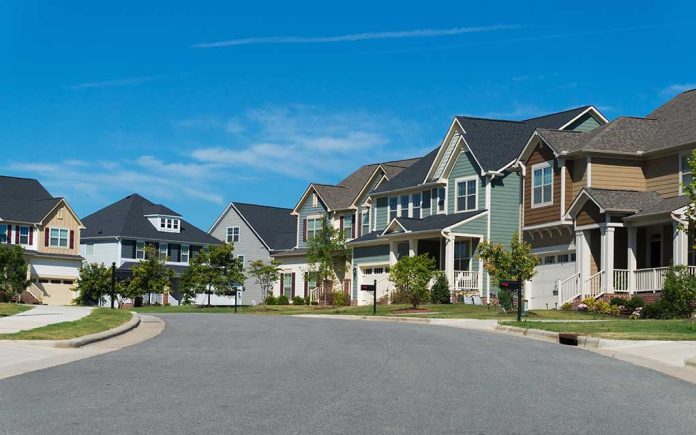
Existing home sales plummeted in March to their slowest pace since the 2009 subprime crisis, signaling potential trouble for the American housing market as high mortgage rates and economic concerns deter buyers despite growing inventory.
Key Takeaways
- Existing home sales dropped 5.9% to a seasonally adjusted annual rate of 4.02 million units in March, marking the slowest pace since 2009.
- High mortgage rates hovering near 7%, rising home prices, and economic uncertainty are creating significant affordability challenges for potential buyers.
- Housing inventory increased by 19.8% year-over-year, with homes staying on the market longer (36 days versus 33 days a year ago).
- The median home price rose 2.7% to $403,700, the smallest annual gain since August, while distressed sales increased to 3% from 2% a year ago.
- First-time buyers constituted only 32% of purchases, well below the historical average of 40%, as affordability pressures mount.
Housing Market Reaches Concerning Lows
March’s housing data reveals a market struggling under the weight of persistently high mortgage rates and economic uncertainty. The National Association of Realtors reported that existing home sales fell to a seasonally adjusted annual rate of 4.02 million, underperforming market expectations of 4.13 million units. This 5.9% decline represents the weakest March performance since the aftermath of the subprime mortgage crisis in 2009. The stark numbers reflect the challenging environment facing both buyers and sellers in today’s market, where affordability remains the primary obstacle for many Americans hoping to purchase homes.
While sales declined, housing inventory climbed by 8.1% from February, reaching 1.33 million units available for sale. This represents a substantial 19.8% increase compared to March of last year. The growing inventory has extended the time properties remain on the market to an average of 36 days, up from 33 days a year ago. At the current sales pace, it would take approximately 4 months to exhaust the available inventory, compared to 3.2 months during the same period last year—signaling a gradual shift from the extreme seller’s market of recent years.
The US housing market was awfully quiet in March
Existing home sales:
• Year-over-Year: -2.4%
• Month-over-month: -5.9%• Slowest March pace since 2009
• Biggest MoM decline since Nov. 2022Not for a lack of listings, the YoY supply was up 20%… pic.twitter.com/yKAEdfOquJ
— Morning Brew ☕️ (@MorningBrew) April 24, 2025
Affordability Challenges Mount for Buyers
The primary factor suppressing home sales continues to be high mortgage rates, which hovered around 7% when many of March’s purchases were initially contracted. These elevated rates, combined with rising home prices, have created significant affordability challenges for potential buyers. The median existing home price in March was $403,700, representing a 2.7% increase from the previous year—though this marks the smallest annual gain since August, suggesting some cooling in the rapid price appreciation seen in recent years as inventory builds.
First-time homebuyers, who traditionally drive market growth, accounted for just 32% of purchases in March—consistent with the previous year but significantly below the historical average of 40%. This persistent underrepresentation of first-time buyers highlights the growing difficulty younger Americans face in achieving homeownership. Meanwhile, all-cash transactions decreased to 26% of sales from 28% a year ago, indicating that even buyers with substantial financial resources are proceeding cautiously in the current economic climate.
Economic Uncertainty Clouds Market Outlook
Beyond the immediate challenges of high mortgage rates and prices, broader economic concerns are weighing on the housing market. Uncertainty about employment stability, persistent inflation, and potential impacts from tariffs are causing potential buyers to hesitate. The National Association of Realtors reported an increase in canceled contracts during March, with warnings that further volatility in financial markets could lead to additional cancellations. These economic pressures are creating a perfect storm that may further depress housing activity in the coming months.
Regional data shows varied market conditions across the country. Notably, the West was the only region to post a year-over-year gain in sales, primarily driven by strong activity in the Rocky Mountain states. This regional disparity highlights how local economic conditions are increasingly influencing housing market performance. In contrast to the struggling existing home market, new home sales surged to a six-month high in March, as builders offered various incentives—including mortgage rate buydowns—to attract buyers, providing one bright spot in an otherwise challenging environment.
With distressed sales, including foreclosures, increasing to 3% from 2% a year ago, there are early warning signs of potential financial stress among homeowners. For Americans approaching retirement age, these housing market conditions present particular challenges, potentially affecting retirement plans for those counting on home equity as a significant portion of their financial security. As the Federal Reserve maintains its cautious approach to interest rate adjustments, mortgage rates may remain elevated through much of 2025, suggesting continued pressure on housing affordability.









